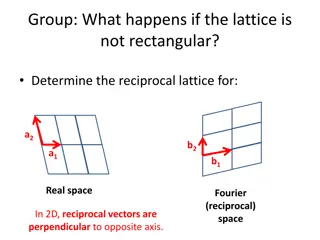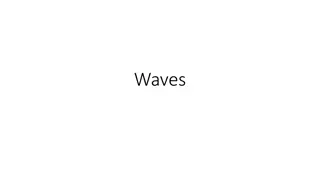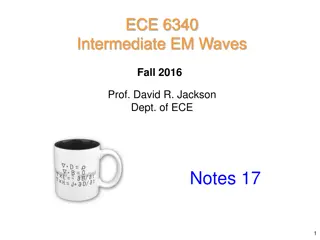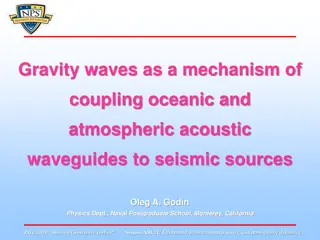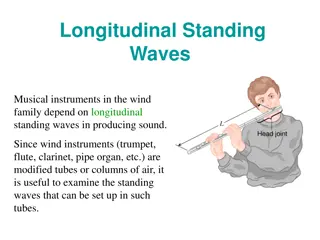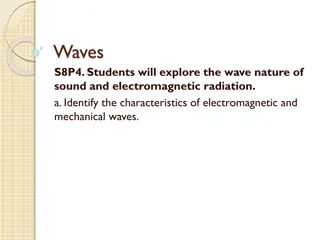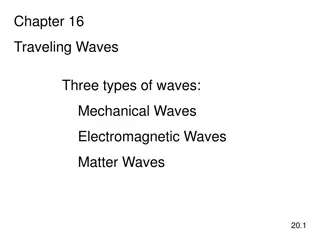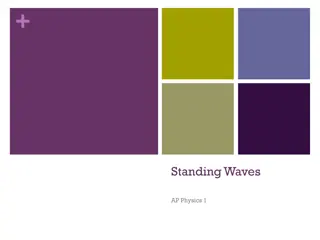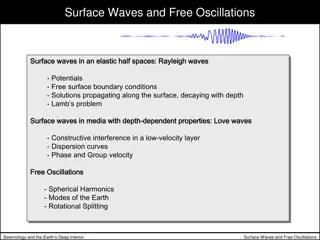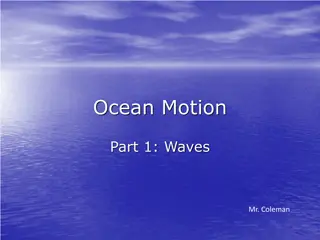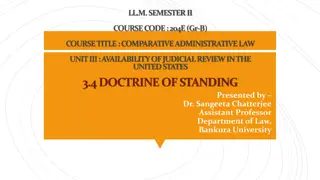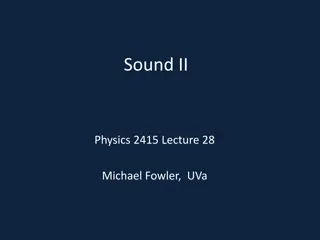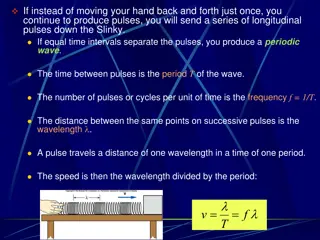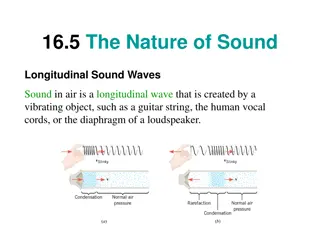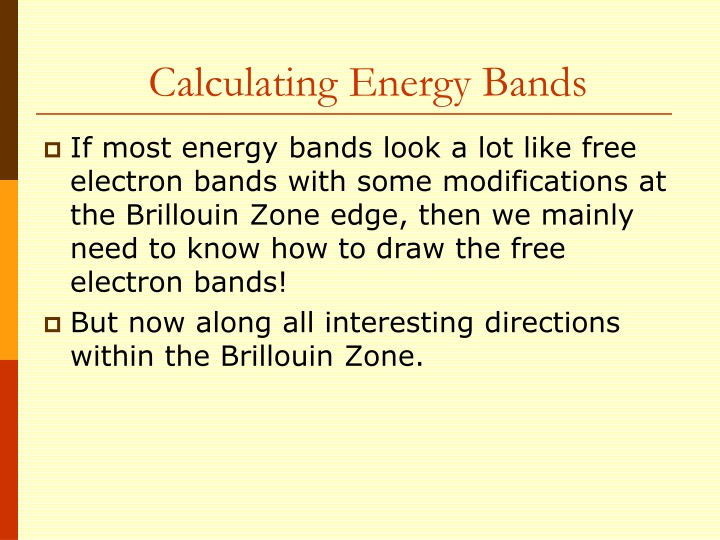
Calculating Energy Bands in Different Lattice Structures
Learn how to calculate energy bands in various lattice structures like bcc and fcc using reciprocal lattice vectors. Understand the differences in band diagrams and explore empty lattice bands for bcc lattice along specific directions in reciprocal space. Discover the maximum values of x, y, and z within the 1st Brillouin Zone and their dependence on lattice type.
Download Presentation

Please find below an Image/Link to download the presentation.
The content on the website is provided AS IS for your information and personal use only. It may not be sold, licensed, or shared on other websites without obtaining consent from the author. If you encounter any issues during the download, it is possible that the publisher has removed the file from their server.
You are allowed to download the files provided on this website for personal or commercial use, subject to the condition that they are used lawfully. All files are the property of their respective owners.
The content on the website is provided AS IS for your information and personal use only. It may not be sold, licensed, or shared on other websites without obtaining consent from the author.
E N D
Presentation Transcript
Calculating Energy Bands If most energy bands look a lot like free electron bands with some modifications at the Brillouin Zone edge, then we mainly need to know how to draw the free electron bands! But now along all interesting directions within the Brillouin Zone.
+ 2 2 ( 2 / ) h k a What makes the band diagrams for a bcc look different than an fcc? = ( ) k E 2 m k /a /a More generically: 2 2 h k 2 2 ( ) h k nG = ( ) k = nk 2 m 2 m
Empty Lattice Bands for bcc Lattice For the bcc lattice, let s plot the empty lattice bands along the [100] direction in reciprocal space. a k h k 2 + 2 2 ( 2 / ) What makes the band diagrams for a bcc look different than an fcc? = ( ) m E k /a /a More generically: 2 2 h k 2 2 ( ) h k nG = ( ) k = nk 2 m 2 m
Empty Lattice Bands for bcc Lattice For the bcc lattice, let s plot the empty lattice bands along the [100] direction in reciprocal space. a = + + General reciprocal lattice translation vector: Ghkl h k b c l
Empty Lattice Bands for bcc Lattice For the bcc lattice, let s plot the empty lattice bands along the [100] direction in reciprocal space. a = + + General reciprocal lattice translation vector: Ghkl h k b c l Let s use a simple cubic lattice, for which the reciprocal lattice is also simple cubic: 2 2 2 = = = x y z a b c a a a And thus the general reciprocal lattice translation vector is: 2 2 2 = + + x y z Ghkl h k l a a a (but only certain values allowed)
Energy Bands in BCC (Pay attention: Similar HW problem) We write the reciprocal lattice vectors that lie in the 1stBZ as: =2? ?? ? +2? ?? ? +2? ? ?? ? The maximum value(s) of x, y, and z depend on the reciprocal lattice type and the direction within the 1stBZ. For example: Remember that the reciprocal lattice for a bcc direct lattice is fcc!
Energy Bands in BCC (Similar HW) We write the reciprocal lattice vectors that lie in the 1stBZ as: =2? ?? ? +2? ?? ? +2? ? ?? ? The maximum value(s) of x, y, and z depend on the reciprocal lattice type and the direction within the 1stBZ. For example: To H=[100] 0 < x < 1, y=0=z 2 a H ky Remember that the reciprocal lattice for a bcc direct lattice is fcc! 2 N a H Here is a top view, from the + kzdirection: kx
Energy Bands in BCC (Similar HW) We write the reciprocal lattice vectors that lie in the 1stBZ as: =2? ?? ? +2? ?? ? +2? ? ?? ? The maximum value(s) of x, y, and z depend on the reciprocal lattice type and the direction within the 1stBZ. For example: To H=[100] 0 < x < 1, y=0=z 0 < x < , 0 < y < , z=0 To N=[110] H ky Remember that the reciprocal lattice for a bcc direct lattice is fcc! N H Here is a top view, from the + kzdirection: kx
Group: Plot the Empty Lattice Bands for bcc Lattice Thus the empty lattice energy bands are given by: 2 2 2 2 ( ) ( ) ( ) 2 2 2 2 = = + + ( ) E k k G x h y k z l 1 hkl 2 2 m m a Along [100], we can enumerate the lowest few bands for the y = z = 0 case, using only G vectors that have nonzero structure factors (h + k + l = even, otherwise S=0):
Group: Plot the Empty Lattice Bands for bcc Lattice Thus the empty lattice energy bands are given by: 2 2 2 2 ( ) ( ) ( ) 2 2 2 2 = = + + ( ) E k k G x h y k z l 1 hkl 2 2 m m a Along [100], we can enumerate the lowest few bands for the y = z = 0 case, using only G vectors that have nonzero structure factors (h + k + l = even, otherwise S=0): {G} = {000}
Group: Plot the Empty Lattice Bands for bcc Lattice Thus the empty lattice energy bands are given by: 2 2 2 2 ( ) ( ) ( ) 2 2 2 2 = = + + ( ) E k k G x h y k z l 1 hkl 2 2 m m a Along [100], we can enumerate the lowest few bands for the y = z = 0 case, using only G vectors that have nonzero structure factors (h + k + l = even, otherwise S=0): 2 ( ) x ( ) x 2 2 {G} = {000} = = 2 2 E E 0 2 m a
Group: Plot the Empty Lattice Bands for bcc Lattice Thus the empty lattice energy bands are given by: 2 2 2 2 ( ) ( ) ( ) 2 2 2 2 = = + + ( ) E k k G x h y k z l 1 hkl 2 2 m m a Along [100], we can enumerate the lowest few bands for the y = z = 0 case, using only G vectors that have nonzero structure factors (h + k + l = even, otherwise S=0): What if we plotted along [110]? 2 ( ) x ( ) x 2 2 {G} = {000} = = 2 2 E E 0 2 m a
Group: Plot the Empty Lattice Bands for bcc Lattice Thus the empty lattice energy bands are given by: 2 2 2 2 ( ) ( ) ( ) 2 2 2 2 = = + + ( ) E k k G x h y k z l 1 hkl 2 2 m m a Along [100], we can enumerate the lowest few bands for the y = z = 0 case, using only G vectors that have nonzero structure factors (h + k + l = even, otherwise S=0): What if we plotted along [110]? 2 ( ) x ( ) x 2 2 {G} = {000} = = 2 2 E E 0 What other values of h,k,l? 2 m a
Group: Plot the Empty Lattice Bands for bcc Lattice Thus the empty lattice energy bands are given by: 2 2 2 2 ( ) ( ) ( ) 2 2 2 2 = = + + ( ) E k k G x h y k z l 1 hkl 2 2 m m a Along [100], we can enumerate the lowest few bands for the y = z = 0 case, using only G vectors that have nonzero structure factors (h + k + l = even, otherwise S=0): What if we plotted along [110]? 2 ( ) x ( ) x 2 2 {G} = {000} = = 2 2 E E 0 What other values of h,k,l? 2 m a {G} = {110} Is it just 110 or the family?
Group: Plot the Empty Lattice Bands for bcc Lattice Thus the empty lattice energy bands are given by: 2 2 2 2 ( ) ( ) ( ) 2 2 2 2 = = + + ( ) E k k G x h y k z l 1 hkl 2 2 m m a Along [100], we can enumerate the lowest few bands for the y = z = 0 case, using only G vectors that have nonzero structure factors (h + k + l = even, otherwise S=0): What if we plotted along [110]? 2 ( ) x ( ) x 2 2 {G} = {000} = = 2 2 E E 0 What other values of h,k,l? 2 m a ( ) 2 = 1 + 110 ( 1 ( ) ( ) 0 1 101 ( ) 10 ) 1 {G} = {110} 2 1 E E x 0 Is it just 110 or the family?
Group: Plot the Empty Lattice Bands for bcc Lattice Thus the empty lattice energy bands are given by: 2 2 2 2 ( ) ( ) ( ) 2 2 2 2 = = + + ( ) E k k G x h y k z l 1 hkl 2 2 m m a Along [100], we can enumerate the lowest few bands for the y = z = 0 case, using only G vectors that have nonzero structure factors (h + k + l = even, otherwise S=0): What if we plotted along [110]? 2 ( ) x ( ) x 2 2 {G} = {000} = = 2 2 E E 0 What other values of h,k,l? 2 m a ( ( ) ) 2 = 1 + 110 ( 1 ( ) ( ) 0 1 101 ( ) 10 ) 1 {G} = {110} 2 1 E E x 0 Is it just 110 or the family? 2 = + 1 + 2 1 ( 1 ( ) 0 1 1 ( ) 10 1 ( ) 1 0 01 ) 1 E E x 0 2 ( ) x 2 = + + = + ( 011 ( ) 0 ( ) 1 01 1 0 ( ) 1 ) 1 1 2 2 2 1 1 E E E x 0 0
Group: Plot the Empty Lattice Bands for bcc Lattice Thus the empty lattice energy bands are given by: 2 2 2 2 ( ) ( ) ( ) 2 2 2 2 = = + + ( ) E k k G x h y k z l 1 hkl 2 2 m m a Along [100], we can enumerate the lowest few bands for the y = z = 0 case, using only G vectors that have nonzero structure factors (h + k + l = even, otherwise S=0): What if we plotted along [110]? 2 ( ) x ( ) x 2 2 {G} = {000} = = 2 2 E E 0 What other values of h,k,l? 2 m a ( ( ) ) 2 = 1 + 110 ( 1 ( ) ( ) 0 1 101 ( ) 10 ) 1 {G} = {110} 2 1 E E x 0 Is it just 110 or the family? 2 = + 1 + 2 1 ( 1 ( ) 0 1 1 ( ) 10 1 ( ) 1 0 01 ) 1 E E x 0 2 ( ) x x ( x ( ) x 2 = + + = + ( 011 ( ) 0 ( ) 1 01 1 0 ( ) 1 ) 1 1 2 2 2 1 1 E E E x 0 0 ( ) ) {G} = {200} ( 200 ) 2 = 2 E E 0 2 ( 00 ) 2 = + 2 E E 0 4 2 = + = + ( 020 0 ( ) ( ) 0 2 002 ( ) 00 ) 2 2 2 2 E E E x 0 0
Empty Lattice Bands for bcc Lattice: Results 2 2 2 2 ( ) ( ) ( ) 2 2 2 2 = = + + ( ) E k k G x h y k z l 1 hkl 2 2 m m a ( ) Thus the lowest energy empty lattice energy bands along the [100] direction for the bcc lattice are: 6 A good approximation for BCC monovalent metals. 2 = + + 2 2 ( ) E k E x h k l 0 5 4 Series1 Series2 Series3 Series4 Series6 Series7 Series8 E/E0 3 2 1 0 0 0.2 0.4 0.6 0.8 1 x
Including a Periodic U(x) in Sch. Eq. Realistic Atomic Potentials in Solids Multi-electron atomic potentials are complex Even for hydrogen atom with a simple Coulomb potential solutions are quite complex U (x ) While these are complex, it turns out that any periodic potential actually shows the general trend, so we can use an easy one to see what happens.
Bringing Atoms Close Together in a Periodic Fashion For one dimensional case where atoms (ions) are separated by distance a, we can write the condition of periodicity as ) ( U x U = + ( ) x a n a a
Bringing Atoms Close Together in a Periodic Fashion For one dimensional case where atoms (ions) are separated by distance a, we can write the condition of periodicity as ) ( U x U = + ( ) x a n Even in a more complicated multi-atomic chain, we can use the same formula a a
Bringing Atoms Close Together in a Periodic Fashion For one dimensional case where atoms (ions) are separated by distance a, we can write the condition of periodicity as ) ( U x U = + ( ) x a n Even in a more complicated multi-atomic chain, we can use the same formula Common misconception: Band gaps occur even without periodicity, but periodic examples are simpler! a a
Bringing Atoms Close Together in a Periodic Fashion For one dimensional case where atoms (ions) are separated by distance a, we can write the condition of periodicity as ) ( U x U = + ( ) x a n Even in a more complicated multi-atomic chain, we can use the same formula Note: Band gaps occur even without periodicity, but periodic examples are simpler! a a Bloch electrons are electrons that obey the Schrodinger equation with a periodic potential.
Bringing Atoms Close Together in a Periodic Fashion For one dimensional case where atoms (ions) are separated by distance a, we can write the condition of periodicity as ) ( U x U = + ( ) x a n Even in a more complicated multi-atomic chain, we can use the same formula Note: Band gaps occur even without periodicity, but periodic examples are simpler! a a Bloch electrons are electrons that obey the Schrodinger equation with a periodic potential. They reduce to free electrons if you take U(x) = 0 = U(x+an)
Bloch Wavefunctions a Bloch s Theorem states that for a particle moving in the periodic potential, the wavefunctions nk(x) are of the form = ikx u ) a is periodic function ( ) ( ) , u ( x u x e where x nk nk nk = + ( ) ( ) x u x a nk nk The wavefunction contains: A phase factor eikx And a periodic function u with the same periodicity as the unit cell
Bloch Wavefunctions a Bloch s Theorem states that for a particle moving in the periodic potential, the wavefunctions nk(x) are of the form = ikx u ) a is periodic function ( ) ( ) , u ( x u x e where x nk nk nk = + ( ) ( ) x u x a nk nk unk(x) has the periodicity of the atomic potential The exact form of u(x) depends on the potential associated with atoms (ions) that form the solid
Kittels Restatement It looks a little different because he rewrites the potential energy as a Fourier series Discussed in both Kittel and Ashcroft This method used in Kittel for next example I will do it a different way because confusing.
What periodic potential do we want to try? To better understand how band gaps form, let s model a 1D crystal, i.e. a lattice with a periodic potential. U(x) Ion core a x The exact shape of the periodic potential will not matter, and these potentials could be complicated.
One Common Approach But the exact shape doesn t matter, so let s try something easier! What s Easy?
One Common Approach But the exact shape doesn t matter, so let s try something easier! What s Easy? A Physicist Thinks Quantum Wells are Easy (Kroniq-Penney Model or Nearly Free Electron Approx.) We ll later discuss a chemist s approach. U(x) x
Using Blochs Theorem: The Krnig-Penney Model Bloch s theorem allows us to calculate the energy bands of electrons in a crystal if we know the potential energy function.
Using Blochs Theorem: The Krnig-Penney Model Bloch s theorem allows us to calculate the energy bands of electrons in a crystal if we know the potential energy function. First done for a chain of finite square well potentials model by Kr nig and Penney in 1931 with E<U0 U(x) U0 x -b 0 aa+b 2a+b 2(a+b)
Using Blochs Theorem: The Krnig-Penney Model Bloch s theorem allows us to calculate the energy bands of electrons in a crystal if we know the potential energy function. First done for a chain of finite square well potentials model by Kr nig and Penney in 1931 with E<U0 U(x) Each atom is represented by a finite square well of width a and depth U0. The atomic spacing is a+b. U0 x -b 0 aa+b 2a+b 2(a+b)
Using Blochs Theorem: The Krnig-Penney Model Bloch s theorem allows us to calculate the energy bands of electrons in a crystal if we know the potential energy function. First done for a chain of finite square well potentials model by Kr nig and Penney in 1931 with E<U0 U(x) Each atom is represented by a finite square well of width a and depth U0. The atomic spacing is a+b. U0 x -b 0 aa+b 2a+b 2(a+b) 2 2 2 d + = E ( ) U x We can solve the SE in each region of space: 2 m dx
Using Blochs Theorem: The Krnig-Penney Model Bloch s theorem allows us to calculate the energy bands of electrons in a crystal if we know the potential energy function. First done for a chain of finite square well potentials model by Kr nig and Penney in 1931 with E<U0 U(x) Each atom is represented by a finite square well of width a and depth U0. The atomic spacing is a+b. U0 x -b 0 aa+b 2a+b 2(a+b) 2 2 2 d + = E ( ) U x We can solve the SE in each region of space: 2 m dx 2 2 K = E = + iKx iKx ( ) x Ae Be 0 < x < a 2 m I
Using Blochs Theorem: The Krnig-Penney Model Bloch s theorem allows us to calculate the energy bands of electrons in a crystal if we know the potential energy function. First done for a chain of finite square well potentials model by Kr nig and Penney in 1931 with E<U0 U(x) Each atom is represented by a finite square well of width a and depth U0. The atomic spacing is a+b. U0 x -b 0 aa+b 2a+b 2(a+b) 2 2 2 d + = E ( ) U x We can solve the SE in each region of space: 2 m dx 2 2 K = E = + iKx iKx ( ) x Ae Be 0 < x < a 2 m I Now what? 2 2 = + x x ( ) = x Ce De U E -b < x < 0 0 II 2 m
= + iKx iKx ( ) x Ae Be I Boundary Conditions and Bloch s Theorem The solutions of the SE require that the wavefunction and its derivative be continuous across the potential boundaries. Thus, at the two boundaries (which are infinitely repeated): x x = + ( ) x Ce De II
= + iKx iKx ( ) x Ae Be I Boundary Conditions and Bloch s Theorem The solutions of the SE require that the wavefunction and its derivative be continuous across the potential boundaries. Thus, at the two boundaries (which are infinitely repeated): C B A + = + x x = + ( ) x Ce De II = ( ) ( ) iK A B C D (2) D (1) x = 0 What else can we do?
= + iKx iKx ( ) x Ae Be I Boundary Conditions and Bloch s Theorem The solutions of the SE require that the wavefunction and its derivative be continuous across the potential boundaries. Thus, at the two boundaries (which are infinitely repeated): C B A + = + x x = + ( ) x Ce De II = ( ) ( ) iK A B C D (2) D (1) x = 0 Use Bloch s Theorem otherwise wavefunction not in terms of k. What else can we do?
= + iKx iKx ( ) x Ae Be I Boundary Conditions and Bloch s Theorem The solutions of the SE require that the wavefunction and its derivative be continuous across the potential boundaries. Thus, at the two boundaries (which are infinitely repeated): C B A + = + x x = + ( ) x Ce De II + = = ( ) ( ) iK A B C D (2) D (1) x = 0 ikR ( ) ( ) x R e x + = iKa iKa (a ) Ae Be x = a II
= + iKx iKx ( ) x Ae Be I Boundary Conditions and Bloch s Theorem The solutions of the SE require that the wavefunction and its derivative be continuous across the potential boundaries. Thus, at the two boundaries (which are infinitely repeated): C B A + = + x x = + ( ) x Ce De II + = = ( ) ( ) iK A B C D (2) D (1) x = 0 ikR ( ) ( ) x R e x + = iKa iKa (a ) Ae Be x = a II Now using Bloch s theorem for R= -(a+b): k = Bloch wavevector + = ( ) ik a b ( ) ( ) a b e II II
= + iKx iKx ( ) x Ae Be I Boundary Conditions and Bloch s Theorem The solutions of the SE require that the wavefunction and its derivative be continuous across the potential boundaries. Thus, at the two boundaries (which are infinitely repeated): C B A + = + x x = + ( ) x Ce De II + = = ( ) ( ) iK A B C D (2) D (1) x = 0 ikR ( ) ( ) x R e x + = iKa iKa (a ) Ae Be x = a II Now using Bloch s theorem for R= -(a+b): k = Bloch wavevector + = ( ) ik a b ( ) ( ) a b e II II Now we can write the boundary conditions at x = a: (3) + + = + ( ) iKa iKa b b ik a b ( ) Ae Be Ce De e + + = + ( ) (4) iKa iKa b b ik a b ( ) ( ) ( ( ) ( ) ) iK ik Ae iK ik Be ik Ce ik De e
= + iKx iKx ( ) x Ae Be I Boundary Conditions and Bloch s Theorem The solutions of the SE require that the wavefunction and its derivative be continuous across the potential boundaries. Thus, at the two boundaries (which are infinitely repeated): C B A + = + x x = + ( ) x Ce De II + = = ( ) ( ) iK A B C D (2) D (1) x = 0 ikR ( ) ( ) x R e x + = iKa iKa (a ) Ae Be x = a II Now using Bloch s theorem for R= -(a+b): k = Bloch wavevector + = ( ) ik a b ( ) ( ) a b e II II Now we can write the boundary conditions at x = a: The four simultaneous equations (1-4) can be written compactly in matrix form Let s start it! (3) + + = + ( ) iKa iKa b b ik a b ( ) Ae Be Ce De e + + = + ( ) (4) iKa iKa b b ik a b ( ) ( ) ( ( ) ( ) ) iK ik Ae iK ik Be ik Ce ik De e



